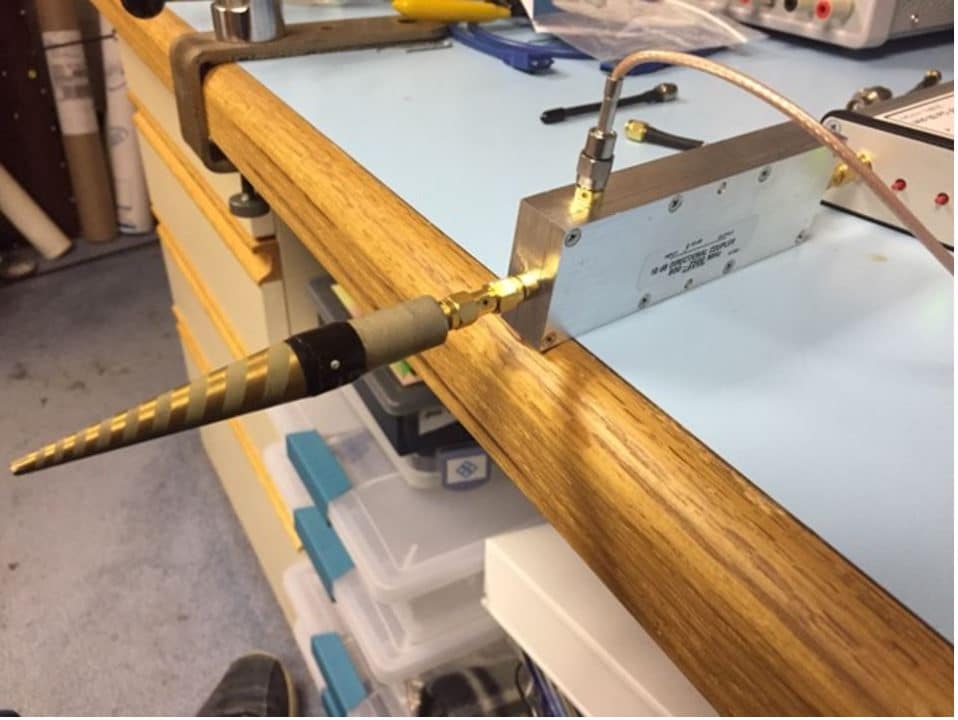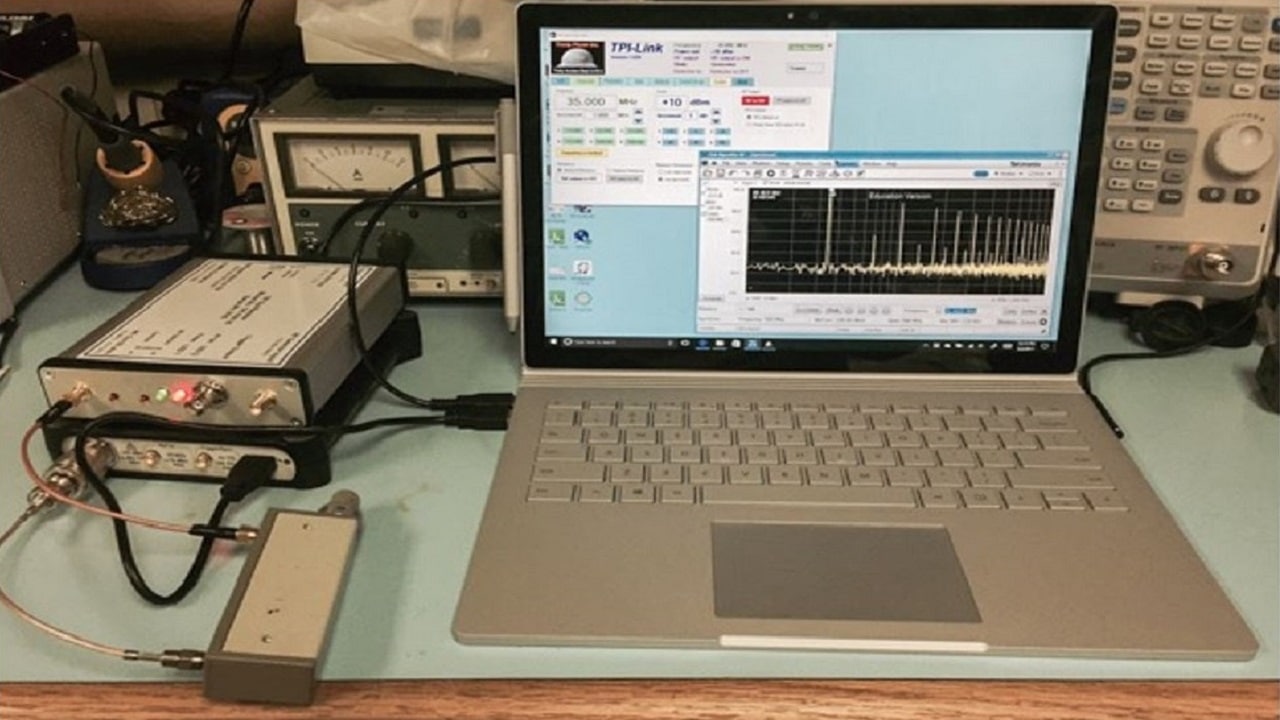I recently had the chance to review a new RF signal generator from Trinity Power Inc. Their model TPI-1001-B is much more than just a mere synthesizer. This improved model also includes several modulations as well as scalar analysis (a “poor man’s” network analyzer).
The product (Figure 1) is available from RF design consultant, Robert Yarbrough (http://www.rf-consultant.com), for the surprisingly low amount of $395. It’s about the size of a shortened VCR tape, is packaged in an extruded aluminum enclosure, and is powered and controlled from a Windows PC using the supplied TPI-Link software. The design of the unit is based on the Analog Devices ADF4351 synthesizer. I previously reviewed the similar TPI Synthesizer Ver 4 earlier that has roughly similar RF output specifications. See Reference 1.

Using the simple Windows software, you can step the frequency anywhere within the entire 35 to 4400 MHz range, and the output power is adjustable from +10 to -90 dBm with +/- 1 dB accuracy across the band – much improved over the earlier model. Output level can be adjusted in 1 dB steps. The output has been tested to be stable and safe with both short and open conditions. This is nice, because it allows direct connection of a near field probe for use as a radiated immunity troubleshooting setup. See Reference 2 for an article on this technique.
The phase noise is just OK and on par with other synthesizers using this IC. At 1GHz (10 kHz offset), it is -91dBc/Hz and at 2.4 GHz (10 kHz offset), it’s -86dBc/Hz.
Besides the basic synthesizer function, the unit also incorporates the following modulations:
- FM (external analog or internal square wave w/adjustable frequency & duty cycle)
- FSK (external digital modulation signal
- AM (external square wave or internal square wave w/adjustable frequency & duty cycle)
- OOK (external digital modulation signal
- Automatic beacon (OOK—includes Morse code generation)
- Modulation Script (ASK or OOK via text script)
This is a big step up from the previous model I reviewed. The AM and OOK (on/off keying, or “pulse”) modulations will be especially useful for radiated or conducted immunity tests per the IEC 6000-4-3, MIL-STD-461, or DO-160 standards. This also provides the potential for using the unit to generate localized RF fields for troubleshooting radiated immunity issues. By connecting a small H-field or E-field probe to the output, easily controllable and localized RF fields may be generated at 3 to 10 V/m levels (depending on frequency). By either sweeping over limited bands or stepping through the typical 80 to 1000 MHz range (IEC 61000-4-3), or higher, you could quickly pinpoint areas of your circuitry that are susceptible to RF fields. This technique has also been described in Interference Technology’s EMC Pre-Compliance Guide (Reference 3).
A number of additional features make the signal generator extremely versatile and include:
- Internal or external 10 MHz frequency reference.
- Frequency and/or level scanning (ramp up, ramp down, or triangle)
- Wideband RF detector input (scalar network analyzer)
- Control script execution (different from the modulation script feature)
- Auxiliary analog input can perform a variety of functions
- Trigger output can trigger on a variety of events
- Stand-alone operation (no computer needed for many functions)

TPI-Link – The software will work under Windows XP, Vista, Windows 7, Windows 8.1, or Windows 10. The unit’s configuration can be saved in nonvolatile (persistent) memory in the unit for use each time the unit is powered. For this reason TPI-Link does not necessarily have to be running whenever the unit is in use, but it facilitates many real-time activities and can monitor the various power supplies in the unit and the unit status.
A very informative “Help” feature is included that describes most of the features found in the TPI-1001-B Signal Generator. For more detailed information on the generator and TPI-Link, visit the product page at Reference 4.
Trial Run – I first set up the unit to run into my Tektronix RSA306B spectrum analyzer. I used a Microsoft Surface Book PC to display the TPI-Link control panel and SignalVu-PC spectrum display simultaneously (Figures 3 and 4).

While the unit never claims to take the place of a lab-quality generator, the features it does include are really extraordinary. One thing to note, though, with all synthesizers using the ADF4351 IC is the series of higher-order harmonics produced (Figure 4). However, the second harmonic was still 10 dB below the level of the fundamental. For the purposes of radiated immunity troubleshooting, this is probably not a great concern, when you realize the next higher harmonic is basically 1/10th the power of the fundamental. Harmonics of the 100 MHz fundamental can be observed all the way out to 6 GHz.

Network Analysis – I was especially interested in the built in capability for scalar network analysis using the RF detector. The RF Detector has about 65 dB of calibrated dynamic range from +10dBm to -55dBm for most frequencies and is accurate within 1 dB. I used it to measure a 150 MHz low pass filter (Figures 5 and 6), a 2450 MHz bandpass filter (Figures 7, 8 and 9), and (using a directional coupler), measured a GPS antenna (Figures 10 and 11).


The network analyzer feature was easy to set up. I found the default red trace color was difficult to read, so changed it to yellow against the black background for much better readability. Connecting the RF output to the detector input and selected “Absolute” to measure and store a reference response. Then, inserted the filter and selected “Relative” to see the resulting response.

Measuring the Wi-Fi passband filter was just as easy. At first, I tried plotting the response across the entire 35 to 4400 MHz range. Interestingly, but probably to no one’s surprise, there were numerous resonances below about 1000 MHz. Zeroing in on a center frequency of 2450 MHz resulted in the expected frequency response.




Summary
While I didn’t attempt to try out all the features, I was quite impressed with the capabilities of the generator itself, as well as the ease of use in using the scalar network analysis mode. All in all, it’s a very impressive instrument. Highly recommended, so long as the harmonic distortion isn’t an issue. Otherwise, the designer can supply custom output filters to greatly reduce these harmonics. At $395, the price is right!
References
- Review of TPI Synthesizer Ver 6 (EDN), http://www.edn.com/electronics-blogs/the-emc-blog/4423710/Review–inexpensive-RF-generator
- Inexpensive Radiated Immunity Pre-Compliance Testing (Interference Technology), https://interferencetechnology.com/inexpensive-radiated-immunity-pre-compliance-testing/
- EMC Pre-Compliance Test Guide (Interference Technology), http://learn.interferencetechnology.com/2017-emc-pre-compliance-test-guide/
- Product description (Trinity Power, Inc.), https://www.rf-consultant.com/tpi-1001-b-signal-generator/




